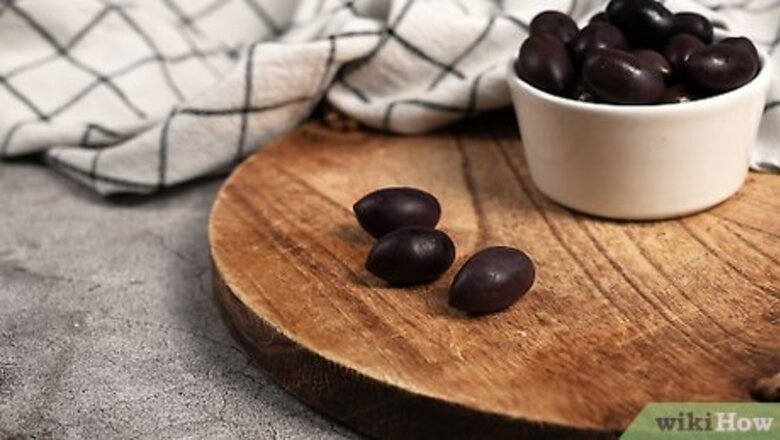
views
- Pit green and black olives by pressing the flat side of a chef’s knife into the olive. Then, remove the pit from the split olive with your fingers.
- Remove the pit from soft, black olives by squeezing them between your thumb and index finger.
- Pit hard, green olives by slicing the flesh from the seed with a paring knife. Or, cut the olive in half vertically and pick out the pit.
Pitting Green & Black Olives with a Chef’s Knife

Put the olives on a clean cutting board. Place your olives on a flat surface, like a cutting board. This prevents your olives from rolling away as you pit them. Plus, it keeps your counter from getting messy with olive juice. Use this method if you’re going to cut up your olives or don’t mind them looking crushed in drinks or salads or as hors d'oeuvres.

Press the flat side of a chef’s knife firmly against the olive. Position your chef’s knife over a single olive, turning the blade away from you. Then, firmly press down on the knife with your palm. Or, use your fist to smash down on the knife, as if you are peeling a garlic clove. Smashing the olive with the knife splits it open and helps separate it from the pit. Simply press down on the olives if you want them to look more intact. Black olives tend to be softer and easier to smash than green olives, which are firmer and usually require more pressure. Some olives, like green Castelvetrano olives, are too firm to safely smash. You need to cut these olives with a paring knife, which we explain below. Note: Use firm but gentle pressure when pressing on the knife. Using a lot of force can break the pit, leaving hard pieces in the flesh.

Pull the knife towards you as you continue to press down. While still pressing the chef’s knife on the olive, gently drag the knife toward you to roll the olive. This helps further loosen the pit from the olive’s flesh. In some cases, the rolling motion squeezes the pit right out of the olive!
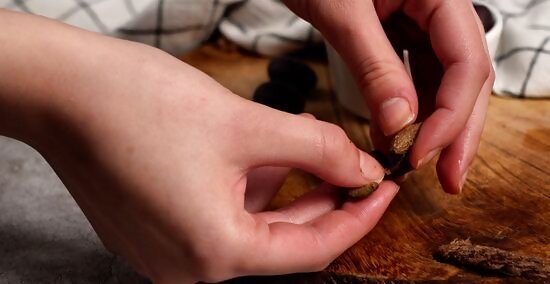
Remove the pit with your fingers if it doesn’t pop out of the olive. Pull the split olive in half and grab the pit. Then, simply pry it from the olive. Simply repeat the smashing steps with the rest of your olives. Make sure to wash your hands before touching the olive and removing the pit.
Pitting Green & Black Olives with a Meat Pounder
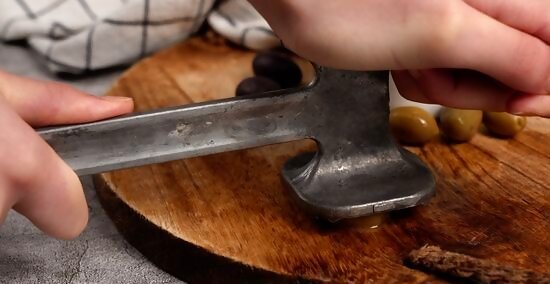
Set your olives on a cutting board and smash them with a meat pounder. Place your olives on a flat surface, like a cutting board or your counter. Then, grab your meat pounder and firmly press or smash it over a single olive. This splits it in half, revealing the pit. To smash more than 1 olive at a time, place your olives in a plastic bag. Then, pound them with the meat pounder. Use any flat object to smash the olives, like a frying pan, saucepan, pestle, or the bottom of a jar. This method crushes your olives. If you want them to look intact, cut them open with a knife or use an olive pitter, which is described below. Note: Do not use a lot of force when smashing the olives. This can break open the pit and leave hard pieces inside the flesh.

Remove the pit with your fingers. Grip the olive where it split apart and pull back the flesh to expose the pit. Then, grab the pit and pull it out of the olive. Simply repeat the steps for the rest of your olives.
Using Your Fingers to Pit Black Olives
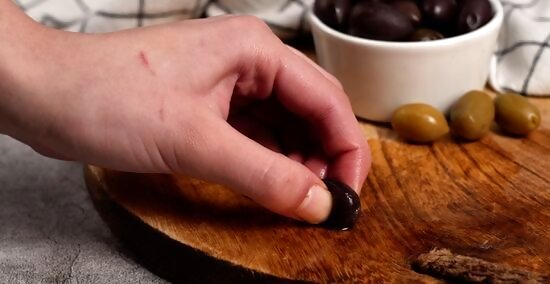
Squeeze the olive between your thumb and index finger. Black olives, especially ones cured in oil, are often soft enough to pit with your fingers! Simply pinch the olive between your thumb and index finger and press down until the olive splits open. Position the long side of the olive between your fingers so you squeeze the entire length of the olive down. Green olives tend to be too tough and firm to squeeze out the pit. This method is great if you plan on cutting up your olives or don’t mind them looking squished.
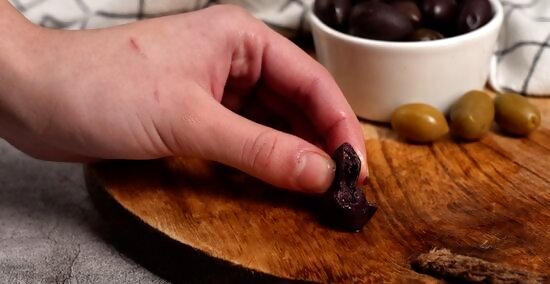
Pull out the pit with your fingers. Open up the olive where it split in half to reveal the pit. Then, use your fingers to grab the pit and take it out of the olive.
Pitting Firm, Green Olives with a Paring Knife
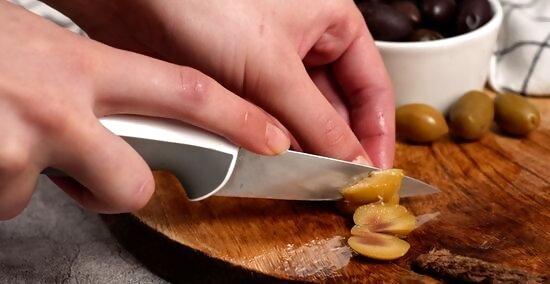
Use a paring knife to cut the olive flesh from the pit. Some green olives have a hard flesh that is firmly attached to the pit, so you have to use a sharp paring knife to cut the pit from the olive. Simply slice off the 4 sides of the olive to reveal the pit, cutting away as much flesh from the pit as possible. This method doesn’t keep the whole olive intact, but it does leave you with uncrushed olive pieces that are great for toppings on salads and in drinks.
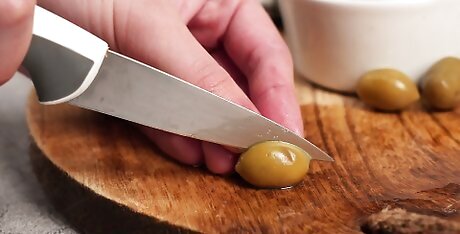
Cut the olive in half with the paring knife as an alternative. Another way to cut hard green olives is to slice the olive vertically in half with a sharp paring knife, as if you are cutting an avocado. Then, twist the halves of the olive apart and take out the pit with your fingers. Use this method if you need larger, uncrushed pieces of olives in your recipe.
Using an Olive Pitter on Black and Green Olives
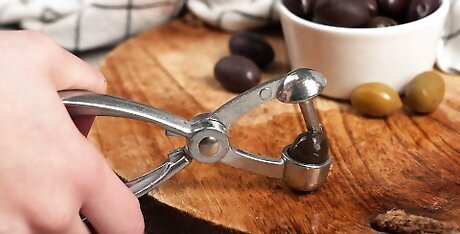
Place the indent on the olive against the pitter and press down. If you find pitting olives by hand too difficult or time-consuming, olive pitters do the work for you. Simply place the indent on the top of the olive against the top of the pitter. Then, squeeze the handle to puncture the olive and push out the pit. Set a small bowl over the pitter to capture the pits if your device doesn’t have a built-in compartment to collect them. Olive pitters are often marketed as cherry and olive pitters. The flesh tends to stick to the pit in firm, green olives, so you might have to use more force for them than for black olives. Using an olive pitter keeps the olives intact, so they are great to use if you’re presenting the olives as hors d'oeuvres at a party or gathering.

Use an olive-pitting machine to pit many olives quickly. Olive-pitting machines are standing devices that typically have several different needle sizes to easily pit a wide range of olive varieties. Like the handheld pitter, you place the olive in the device with the indent face up and press down on the lever to squeeze out the pit. These machines can be bulky and expensive, so they are usually only used by restaurants and food suppliers. Commercial olive harvesters pit olives using a large, mechanized version of this machine. Some machines can pit over 2,000 olives per minute!



















Comments
0 comment